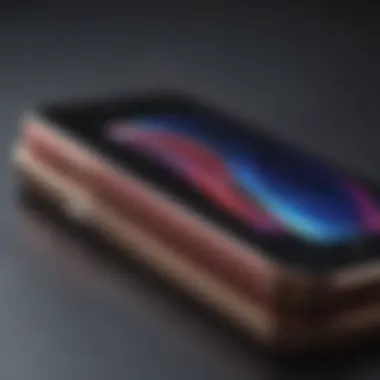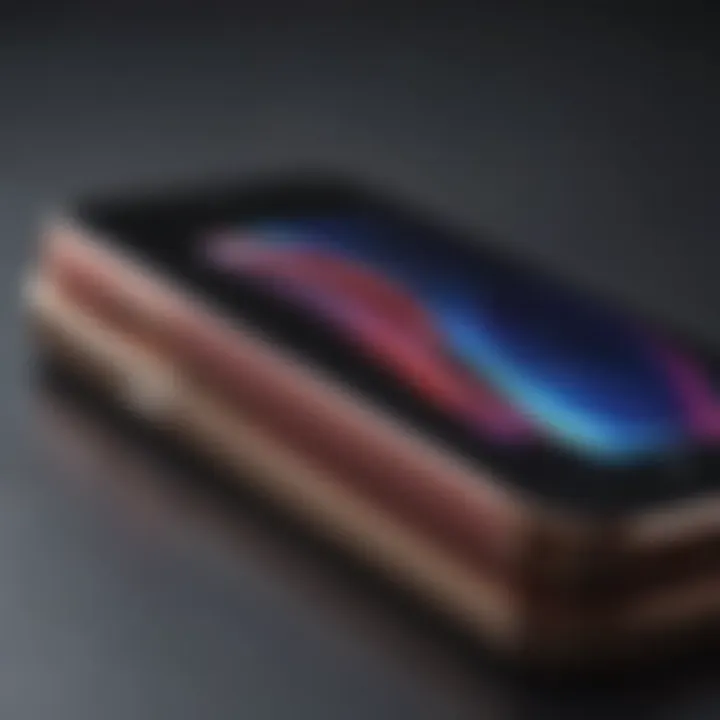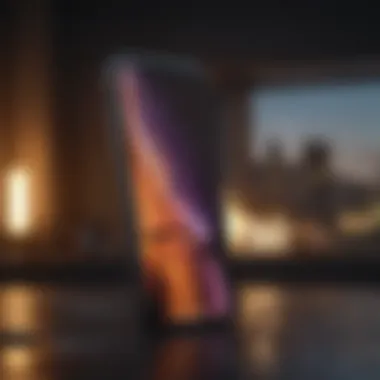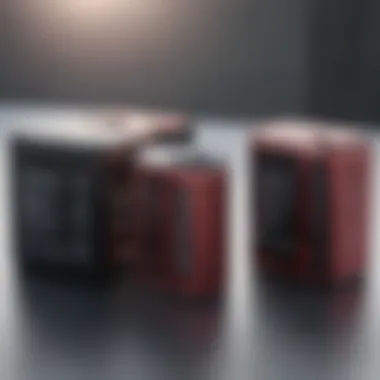iPhone SE vs iPhone XR: In-Depth Comparison Guide


Intro
In the ever-evolving world of smartphones, Apple has introduced various models that cater to a wide array of user preferences and needs. Two devices that stand out for their unique characteristics are the iPhone SE and the iPhone XR. While both may fall under the Apple umbrella, they cater to different segments of the market. The iPhone SE is often seen as a more budget-friendly option that packs a punch in terms of performance, while the iPhone XR is celebrated for its larger display and vibrant features. Understanding the nuances between these two models can significantly impact a potential buyer’s choice.
This article delves deep into the defining traits of the iPhone SE and the iPhone XR, focusing on aspects such as design, performance, display quality, camera capabilities, battery life, and pricing. By meticulously dissecting each feature, we'll clear up any ambiguity and help you navigate the crowded landscape of Apple’s smartphone offerings.
Product Overview
Overview of the Apple product being discussed
The iPhone SE was launched in 2020 and marked a return to the compact phone design that many users appreciated. It combines the powerful A13 chip—a feat seen in the higher-end models—with an affordable price tag. On the flip side, the iPhone XR, released in 2018, is often regarded as a perfect blend of affordability and premium features, incorporating an expansive display and vibrant color options.
Key features and specifications
- iPhone SE: 4.7-inch Retina HD display, A13 Bionic chip, single 12 MP rear camera, Touch ID, and wireless charging capabilities.
- iPhone XR: 6.1-inch Liquid Retina display, A12 Bionic chip, 12 MP dual-camera system (wide and telephoto lenses), Face ID, and extensive color choices.
Comparison with previous models
The iPhone SE represents a shift back to a smaller form factor similar to the iPhone 8, while the iPhone XR expanded on the iPhone X's design language, featuring a notch and improved display technologies. This functional divergence allows each phone to serve a distinct audience, be it those who prefer compact devices or those who appreciate expansive screens.
Performance and User Experience
Performance analysis
Both phones promise swift performance due to their respective chipsets, but the A13 chip in the SE does offer slightly better overall speed, especially when multitasking. The XR's A12 chip holds its own under normal circumstances, but users pushing heavy applications might notice a tad of sluggishness compared to its sibling.
User interface and ease of use
Apple's iOS offers a seamless experience regardless of the device, though operability can differ. The smaller screen on the iPhone SE may appeal to those who prefer a one-handed usage while the XR’s larger display caters well to media consumption.
User experience feedback and opinions
Many users appreciate the iPhone SE for its simplicity and compactness, allowing for easy handling. In contrast, the XR garners praise for its rich display, making it an excellent choice for gaming and video streaming.
Design and Build Quality
Design elements and aesthetics of the product
The iPhone SE's design can be characterized as straightforward and functional, while the XR showcases a more playful persona, available in a range of bold colors like coral, yellow, and blue.
Materials used in construction
Both phones utilize a mix of glass and aluminum, yet the iPhone XR’s construction gives it a more modern feel and improved durability, thanks to its Ceramic Shield front cover.
Durability and build quality assessments
While both models are sturdy, the iPhone XR may hold an edge in day-to-day resilience against drops and scratches due to its design and materials. Users have noted that the iPhone SE, although well-built, may not withstand the same level of wear and tear over time.
Software and Updates
Operating system features and updates
Both devices run iOS, benefiting from regular updates and security features. However, the iPhone SE may receive a longer lifespan of updates owing to its newer launch period.
App compatibility and availability
With Apple's ecosystem, any app available for iOS will work on these models, but the performance may differ based on hardware specifications. For example, games requiring extensive processing may suffer on older hardware.
User customization options
Users can enjoy the freedom to personalize their devices regardless of the model, but those on the iPhone XR will likely have a more visually immersive experience with a richer display.
Price and Value Proposition
Price point and variants available
The iPhone SE is marketed as a budget-friendly option, while the iPhone XR is slightly pricier but often viewed as an investment in a higher quality experience.
Value for money assessment
Users looking for an affordable experience may feel more inclined toward the iPhone SE. However, those who desire a better display and camera might justify the additional cost of the XR.
Comparison with similar products in the market


When viewed alongside other brands, Apple holds its own, but considerations like weighted pricing and features will ultimately sway buyer confidence. Each model finds its strengths in appealing to different user bases.
Prelims to iPhone SE and iPhone XR
Understanding the differences between the iPhone SE and iPhone XR is crucial for potential buyers navigating Apple’s diverse smartphone lineup. Each device offers unique features that cater to different user preferences, budgets, and technological needs. Knowing these distinctions helps clarify which model aligns better with individual lifestyles, ultimately leading to a more satisfying ownership experience.
Overview of Apple's Smartphone Strategy
Apple has always positioned itself as a frontrunner in the smartphone industry, crafting not just products, but also robust consumer ecosystems. Historically, the company adopts a premium pricing strategy while simultaneously catering to a range of consumers through various models. This strategy aims to cover the spectrum — from budget-conscious buyers looking for reliability in the iPhone SE to those desiring more expansive features in the iPhone XR.
By dissecting their offerings, we see that Apple isn’t merely filling niches; they're strategically expanding their market reach. The introduction of the iPhone SE aimed at providing an entry-level option maintains Apple's brand integrity while offering essential features at a lower price. In contrast, the iPhone XR comes packed with advanced specifications, appealing to those who prioritize display and camera performance.
Positioning of iPhone SE and iPhone XR
The positioning of these two models serves to clarify their target demographics. The iPhone SE, often viewed as a more frugal choice, appeals to users who prefer a smaller, straightforward device without the bells and whistles that often inflate prices.
On the other hand, the iPhone XR is marketed towards a tech-savvy audience willing to invest in more advanced specifications. It features a larger screen and offers a richer experience for users eagerly consuming multimedia and utilizing advanced mobile applications.
In summary, while both models share the fundamental qualities of the iPhone brand, they cater to distinct audiences with unique needs. The iPhone SE delivers a compact and cost-effective solution, whereas the iPhone XR represents a more feature-rich experience that aligns with current smartphone trends.
Design Comparisons
The design of a smartphone carries significant weight in the decision-making process for many tech enthusiasts. It's more than just how the device looks; design influences functionality, user interface, and overall enjoyment. The iPhone SE and iPhone XR embody Apple's approach to design but cater to different aesthetics and preferences. Exploring the design comparisons helps potential buyers identify which model complements their style and usage philosophy.
Physical Dimensions and Build Quality
When it comes to physical dimensions, the iPhone SE is somewhat compact. With its 4.7-inch screen, it’s cozy in the hand and feels snappy for one-handed use. On the flip side, the iPhone XR boasts a 6.1-inch display, offering users a larger viewing area, which is great for media consumption and gaming. Both models are crafted from quality materials, but the XR offers a more premium feel with its aluminum frame and glass back, while the SE sticks to a more traditional design.
"Design isn't just how it looks, it's how it works."
Underneath the surface, the build quality should not be overlooked; both phones are made to stand the test of time. The iPhone SE’s design is a nod to earlier models, featuring a glass front and back, and it feels robust. The XR, although larger, is equally sturdy, thanks to its sleek construction. Users will find a sense of resilience built into both devices.
Color Options and Aesthetics
In terms of color options, the iPhone XR edges out with its broader palette. Available in colors like blue, yellow, coral, and PRODUCT(RED), it speaks to those looking to express their personality through their device. In contrast, the iPhone SE is a bit more understated, primarily offered in black, white, and PRODUCT(RED).
This difference might not seem pivotal, but it reflects the target audience. The XR's appeal lies in its fun and vibrant aesthetics, while the SE attracts a crowd that leans towards classic and minimalist vibes. Ultimately, color choices can sway a buyer's decision based on personal style—do you want to stand out or keep it simple?
User Interface and Ergonomics
Ergonomics plays a significant role in daily usability. The iPhone SE, with its smaller size, fits snugly into most pockets and feels lightweight. For those who prioritize portability, this could be a crucial factor. However, users may find the screen size limiting for multitasking and media consumption.
On the other hand, the iPhone XR, with its edge-to-edge display and larger size, offers a richer viewing experience. It's a little bulkier but designed to fit comfortably in the hand. Apple has done well to enhance usability; gestures and controls are accessible and intuitive on both devices. It all boils down to whether you value portability or a more immersive experience.
In summary, the design of these two models reflects their intended market segments. The iPhone SE aims for simplicity and durability while the iPhone XR embraces a more dynamic and colorful approach. Understanding these nuances in design can play a vital role in making the right choice between these two devices.
Performance Metrics
When it comes to smartphones, the performance metrics are less about bragging rights and more about the real-world impact on user experience. The speed and efficiency of a device can significantly affect everything from app loading times to graphic processing in games. This section will dissect how both iPhone SE and iPhone XR stack against each other by exploring three key elements: the processor, RAM and storage options, and real-world benchmarks.
Processor Comparison
The heart of any smartphone is its processor, and when comparing the iPhone SE and iPhone XR, this holds especially true. The iPhone SE is powered by the A13 Bionic chip, the same powerhouse that fuels the iPhone 11 lineup. That's no small feat. With a six-core CPU design, it provides not just speed but efficiency, allowing the device to handle demanding tasks without breaking a sweat.
On the flip side, the iPhone XR runs on the A12 Bionic chip. While it's still a highly capable processor, it does not quite match the sheer horsepower of the A13, especially in graphics-intensive applications and future-proofing scenarios. When you consider the evolution of apps and mobile games requiring more processing strength, the A13 begins to look like the safer bet. Both processors, however, offer smooth performance for everyday tasks like social media, browsing, and casual gaming,
RAM and Storage Options
Both devices present different approaches to RAM and storage, which can play a crucial role in multitasking and performance longevity. The iPhone SE comes with 3GB of RAM, which proves adequate for the majority of users, but for those who juggle a multitude of apps simultaneously, it can feel limiting.
Conversely, the iPhone XR features 3GB of RAM as well, yet it implements this resource efficiently, making the experience somewhat comparable in performance. In terms of storage, the iPhone SE offers options ranging from 64GB to 256GB, aligning it more with users who favor ample local storage. The iPhone XR, while having similar options, also leans towards providing a slightly more flexible cloud-based approach via iCloud, easing concerns for those who might run out of physical space.
Real-World Performance Benchmarks
Now, let's talk numbers, or rather, user experiences observed through real-world performance benchmarks. In various testing scenarios, the iPhone SE tends to present better results in terms of app loading and system responsiveness. Users have noted that the A13 chip allows for quicker transitions between intensive tasks such as video editing or heavy gaming compared to the iPhone XR's A12 chip.
"In heavy use cases, the iPhone SE shines through with app responsiveness, notably in gaming and media consumption, while the iPhone XR still holds its ground but feels a tad heavier under load."
When it comes to gaming, benchmarks indicate that graphics-heavy titles run smoother on the SE due to its advanced GPU architecture. However, both devices handle daily tasks reliably, ensuring that if you're coming from an older iPhone, either model provides a noticeable boost in performance.
Wrapping it all up, while both the iPhone SE and XR deliver commendable performance, nuances lie in the processing power, memory management, and overall capacity for handling intensive tasks. Choosing between them may ultimately come down to your specific use case, but the metrics above provide valuable insight into which device might suit your needs best.
Display Analysis
When considering a smartphone, the display often serves as a crucial interface between the user and the device. A device’s display influences everything from the quality of media consumption to daily tasks like browsing and texting. An analysis of display characteristics reveals the strengths of the iPhone SE and iPhone XR, offering insights that are essential for potential buyers based on their content consumption habits and everyday usage. In this section, we’ll dissect screen size, technology types, resolution and color accuracy, as well as overall user experience and viewing angles.
Screen Size and Technology


The iPhone SE comes with a compact screen size of 4.7 inches, utilizing Retina HD technology. This size makes the device portable and easy to handle with one hand. It's a classic design that many long-time Apple users appreciate, evoking a sense of nostalgia.
In contrast, the iPhone XR sports a larger, 6.1-inch Liquid Retina display. Not only does it provide a more immersive viewing experience, but the larger screen is ideal for activities like gaming and watching videos. The difference in technology can affect how colors and brightness are rendered as well, making the XR’s display a more appealing option for those who prioritize media consumption.
Resolution and Color Accuracy
Delving into resolution, the iPhone SE has a resolution of 1334 x 750 pixels. While this is respectable for a smaller display, it falls short when stacked against the iPhone XR, which boasts a 1792 x 828 pixel resolution. This means that the XR delivers a higher pixel density, enhancing the sharpness and clarity of images and text.
Color accuracy is another key aspect. The iPhone XR features a wider color gamut, which means it can display more vibrant and true-to-life colors. Users who enjoy photography or video content may notice a marked difference, as images appear richer and more vivid on the XR compared to the SE.
User Experience and Viewing Angles
A pivotal factor in display performance is user experience. The iPhone XR excels with its broader viewing angles; it allows content to be easily seen from different perspectives without significant color distortion. This becomes particularly useful when sharing content with friends or during group calls.
On the other hand, the iPhone SE, while equipped with a good display for its size, may not deliver the same experience in varied lighting conditions or angles, potentially causing a shift in colors or visibility.
"Screen experience can greatly impact productivity and overall enjoyment of the device, making this aspect a non-negotiable for many users."
Camera Capabilities
When it comes to smartphones, the camera is often a make-or-break feature for many users. In this section, we will dive into the camera capabilities of the iPhone SE and iPhone XR, comparing their rear and front camera specifications, functionality, and software features. For individuals who prioritize photography and videography in their mobile devices, understanding these aspects is crucial. Both models present unique offerings that cater to various user preferences, and analyzing their camera functionalities can help potential buyers make a more informed decision.
Rear Camera Specifications
The rear camera is usually the star of the show for most smartphones, and the iPhone SE and iPhone XR do not disappoint. The iPhone SE includes a single 12-megapixel lens with an f/1.8 aperture, enabling it to take sharp and vibrant photos even in lower light settings. In terms of image quality, many users note that the photos have a good balance of detail and color accuracy. The Portrait mode, a favorite among photography enthusiasts, is available on the SE, offering a pleasing bokeh effect.
On the other hand, the iPhone XR also sports a 12-megapixel rear camera but comes with an f/1.8 aperture and utilizes advanced computational photography techniques. The Smart HDR feature distinguishes the XR, allowing for enhanced dynamic range, which captures more details in highlights and shadows. Users have suggested that this results in more balanced photographs overall, especially in varying lighting conditions. Essentially, while both provide excellent camera specifications, the added software magic in the XR's camera functions could sway some users.
Front Camera Functionality
As we turn our attention to the front-facing cameras, there's much to consider. The iPhone SE features a 7-megapixel front camera, equipped with an f/2.2 aperture, which can manage decent selfies and video calls. Its capability to take images using Portrait mode, combined with facial recognition features, keeps the quality up to par for everyday use, especially for those who enjoy social media.
Conversely, the iPhone XR's front camera packs a bit more punch with its 7-megapixel lens that also supports Portrait mode and the amazing capability of Smart HDR. This feature is particularly useful for enhancing selfies, allowing users to capture more detail in their portraits. Additionally, the XR’s front camera includes the functionality for Animoji and Memoji, offering a fun twist for those who like to personalize their messages. It's a small difference, but for some users, that capability might tip the scales.
Camera Software Features
The software that underpins a camera’s capabilities can often be its greatest strength. Both the iPhone SE and iPhone XR leverage iOS's photo processing algorithms, but the differences lie in the specific features each offers. The iPhone SE primarily relies on the conventional camera app for effective shooting, providing essential modes like HDR and Night mode, enhancing low-light performance.
The XR, however, gives users added tools such as advanced Smart HDR, which analyzes scene lighting and adjusts settings for the best possible outcome. Furthermore, the inclusion of Portrait mode on both rear and front cameras comes with lighting effects ranging from natural light to stage light options on the XR, giving photographers more creative control over their shots.
Ultimately, whether one leans towards the simpler setup of the SE or the more sophisticated software offerings of the XR, both phones provide capable cameras designed to meet the diverse needs of its users.
"A good camera doesn’t depend solely on hardware; software magic plays a pivotal role in creating that wow factor in your shots."
Battery Life Examination
The battery life of a smartphone can make or break the user experience. When comparing the iPhone SE and iPhone XR, it’s not merely about how long the devices last on a single charge, but also about how these devices cater to the demands of the modern user. A smartphone’s battery is pivotal in determining its usability, especially for those who lead fast-paced lives or rely heavily on their devices for work or leisure. Thus, understanding the battery capabilities of each phone offers insight into which model might better serve different user needs.
Battery Capacity and Performance
When discussing battery capacity, the iPhone XR emerges with an upper hand due to its larger capacity than the iPhone SE. The XR houses a 2,942 mAh battery compared to the SE's substantially smaller 1,821 mAh battery. This difference implies that, generally speaking, the XR is built to last longer between charges.
The performance of these devices under different usage conditions reveals some interesting contrasts. Users engaged in browsing the web or watching videos on the XR usually find it supports longer playtime. In typical tests, the iPhone XR can last over 15 hours of web browsing or video playback. Therefore, for individuals who often use their phones for streaming media or gaming, the XR is designed to keep up without draining too soon. In contrast, the iPhone SE, while offering efficient performance for standard tasks, may leave users scrambling for a charger during prolonged heavy use.
Charging Options and Times
When it comes to recharging, both devices bring their advantages to the table. The iPhone SE and the iPhone XR both support Apple's fast charging feature, which is always a plus. However, users often notice that the time taken to reach full charge can differ due to battery sizes. The XR can get charged to about 50% in around 30 minutes using a compatible charger, while the SE, due to its smaller battery, can reach a similar charging metric in less time.
Another factor worth mentioning is that both devices are compatible with wireless charging. Users who prefer a cable-free experience will find that both the iPhone SE and XR can seamlessly integrate into their charging routines. However, the speed of charging wirelessly might feel a bit slower, depending on the Qi charger used.
"A smartphone without good battery life is like a car without fuel – no matter how sleek or powerful, it won't take you anywhere."
As per the considerations shared, the differences in battery life and charging can significantly influence a choice between the two models. For those who prioritize endurance and longer usage times, the iPhone XR appears to take the cake while the iPhone SE, being more compact, serves efficiently for lighter users.
Nevertheless, both phones, despite their differences, align with the essential needs of average users but cater to varying lifestyle choices and habits.
Software and User Experience
When comparing the iPhone SE and iPhone XR, the topic of software and user experience is crucial. Operating systems dictate not just how a device performs but also how seamlessly users navigate features and applications. Apple devices are famed for their smooth and intuitive software, and knowing how the SE and XR differ in this area can really influence a buyer’s choice.
Both devices run on Apple’s iOS, ensuring users enjoy a similar core experience. However, various factors come into play. For instance, the iPhone SE, while possessing the same iOS environment, may offer a more simplified interface, appealing to those who favor straightforward operations.
Operating System and Interface


The iPhone SE comes equipped with the latest iOS version, embracing features like improved privacy settings, Dark Mode, and revamped notifications, aimed at elevating user convenience. Its smaller screen estate lends itself to less clutter. This reduced complexity combined with a compact size makes the iPhone SE an attractive option for users who prefer a no-nonsense, agile device that is easy to handle one-handed.
In contrast, the iPhone XR not only runs on the same operating system but benefits from its larger display. Users can fully take advantage of features like the split-screen multitasking, which is handy for professionals or anyone managing multiple tasks simultaneously. The user interface, tailored for larger screens, enhances visibility and allows for a more immersive experience when browsing or video streaming, leading to a certain elegance.
Ecosystem Integration
Apple thrives on creating a closely-knit ecosystem that fosters exceptional user experience. Whether you're using iCloud, Apple Music or taking advantage of AirDrop, the integration of features plays a significant role in day-to-day usability.
For the iPhone SE users, access to this seamless ecosystem means syncing with other Apple products like the iPad or MacBook is a cinch. Folks who own multiple Apple devices often find themselves needing just one Apple ID to have everything bridge together effortlessly. The SE is particularly welcoming for new entrants into the Apple realm, given its lower price point.
On the other hand, the iPhone XR, also benefiting from the ecosystem, enhances integration through its larger battery life. Users can enjoy longer periods engaging with features that connect various devices. Imagine working on a document on a MacBook and picking it up right on the XR without missing a beat—this kind of harmony typifies the Apple experience, proving efficient, productive, and largely enjoyable.
"Apple’s software isn’t just about functionality; it’s about crafting a holistic experience that embraces users across all their devices."
In summary, while both the iPhone SE and iPhone XR promise smooth operation and integration into the Apple ecosystem, differences arise in the experience derived from their designs and target audiences. Users who appreciate simplicity might lean towards the SE, while those who prefer versatility and a richer interface might find the XR more compelling. Ultimately, understanding these nuances in software and user experience is essential for making an educated decision.
Pricing and Availability
In today's rapidly evolving tech landscape, pricing and availability hold significant weight when considering a smartphone purchase. For potential buyers, understanding the cost implications and how a device fits within the market can influence their buying decision substantially. In this segment, we will delve into critical elements surrounding the pricing strategies adopted by Apple for the iPhone SE and iPhone XR, as well as their availability across different regions. Recognizing how these factors interplay helps the consumer navigate their options more strategically.
Price Comparison at Launch
When the iPhone SE made its debut, it came with a competitive price tag of $399. This positioning resonated with consumers seeking a solid Apple experience without the hefty premium of flagship models. On the other hand, the iPhone XR, while still a more budget-friendly option compared to other flagship models at its launch, started at $749. This distinction highlights a rift in target audiences: the iPhone SE aimed more at traditionalists who preferred compact designs and classic features, while the XR reached out to a demographic that favored larger screens and enhanced specifications but at a reasonable cost.
Here’s a clearer picture:
- iPhone SE: Launched at $399
- iPhone XR: Launched at $749
This difference in price points is essential for understanding which device may attract which user types based solely on budget considerations. Buyers often weigh the initial cost against the potential longevity and resale value of the devices.
Current Market Prices
Fast forward to today, and the landscape has shifted with new releases and price adjustments. As of now, current market prices for the iPhone SE hover around $250 to $350, depending on the storage option and condition of the device, while the iPhone XR can be found in the range of $300 to $450. These prices fluctuate based on several factors, including:
- Refurbished vs New: Refurbished devices often present a considerable saving opportunity.
- Carrier Deals: Many telecommunication companies provide incentives for trade-ins or special promotions.
- Condition: A secondhand iPhone XR in excellent condition can demand a price closer to that of the new iPhone SE.
"Price isn’t everything, but it sure is a strong decoder ring for evaluating what features you’ll get."
Although prices can seem fluid, they often indicate how valued a device is after its release cycle has matured. Understanding how the iPhone SE remains more affordable yet practical, when juxtaposed with the iPhone XR's slightly higher current prices, is crucial for consumers aiming to maximize their investment.
Target Audience Analysis
Understanding the target audience is paramount in any analysis and particularly significant when comparing devices like the iPhone SE and iPhone XR. This section will delve into the various user profiles and preferences that guide buyers toward one model over the other. Knowing who these devices serve not only clarifies their market positioning but also helps potential buyers understand which features may best meet their needs.
User Profiles for iPhone SE
The iPhone SE appeals to a niche group of users who value compactness and cost-effectiveness without compromising on performance. Here are some typical profiles:
- Budget-Conscious Consumers: Many users seek a smartphone that delivers robust capabilities without the hefty price tag. The iPhone SE serves as an attractive alternative, offering a solid array of features at a lower entry price.
- Small Hands, Small Devices: A section of users prefers devices that can be easily manipulated with one hand. The compact size of the SE makes it a comfortable fit for people who are tired of struggling with larger devices.
- Apple Ecosystem Newcomers: Some buyers, particularly those attracted by Apple's renowned ecosystem, may be hesitant to invest in higher-end models. The SE offers a taste of that ecosystem and serves as a gateway for users new to Apple.
These profiles highlight the iPhone SE’s appeal to those looking for practicality, ease of use, and a friendly price point.
User Profiles for iPhone XR
In contrast, iPhone XR attracts a different crowd—those who want a balance of performance and features while still being reasonably priced. Consider these user profiles:
- Photography Enthusiasts: With its superior camera capabilities compared to the SE, users looking to capture high-quality photos will find the XR appealing. It provides more advanced features such as Smart HDR and enhanced low-light performance.
- Entertainment Seekers: The larger display and vibrant color options of the XR attract those who relish streaming videos or playing games on their devices. The immersive experience afforded by the XR’s screen is a selling point for this demographic.
- Tech Savvy Individuals: Users who appreciate the nuances of technology are often drawn to the XR's features, like Face ID and a more advanced chipset, making it a more future-proof option.
Each of these profiles clarifies the unique brand engagement offered by the iPhone XR, catering to those who desire more versatility and functionality.
"Understanding the intricacies of target audiences allows for informed purchasing decisions, aligning devices with the specific needs and aspirations of users."
In summary, recognizing the differences in user profiles for the iPhone SE and XR shines a light on their respective strengths. This analysis not only supports potential buyers in making educated choices but also highlights the diverse market strategy Apple employs by providing options tailored to distinct user expectations.
Final Thoughts
When weighing the options between the iPhone SE and the iPhone XR, it’s essential to take a moment to reflect on your own needs and preferences. The importance of this section cannot be overstated, as it allows you to synthesize the information already presented in the previous sections—design elements, performance metrics, camera capabilities, and even pricing. Choosing a smartphone is not just about specs on paper; it’s about how the device fits your lifestyle and usage paradigms.
Which Device Suits Your Needs?
Choosing between the iPhone SE and the iPhone XR rests heavily on understanding your own user profile. The iPhone SE, with its compact size and affordable price point, caters well to those who prefer simple functionality, perhaps with less focus on the bells and whistles found in higher-end models. It’s a great match for students, casual users, or folks who just want a phone that gets the job done without extraneous features.
On the other hand, the iPhone XR comes packed with features that appeal to more enthusiastic users. The larger screen, better camera capabilities, and richer color options make it a solid pick for someone who engages with their phone more robustly—be it for photography, gaming, or media consumption. If you find yourself scrolling through social media or binge-watching shows, the XR could enhance that experience markedly.
Future-Proofing Your Purchase
Another important consideration is the concept of future-proofing. The tech industry moves at a lightning pace, and it’s wise to think ahead. Investing in the iPhone XR may mean you’re more equipped to handle future iOS updates and features, thanks to its newer internals and overall capabilities. It has a broader range of features, so even as apps and software become more demanding, it’s likely to keep up longer than the SE.
If you are someone who doesn’t upgrade often, this becomes even more pertinent. The XR might offer a longer shelf-life in terms of performance and features, making it feel less outdated down the line.
"Investing wisely means being aware of how your phone will adapt to impending technological shifts."



